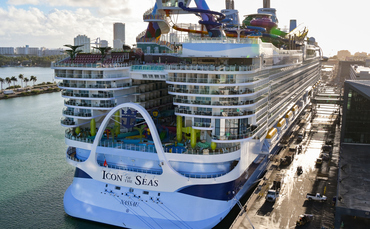The number and size of cruise ships has surged since the turn of the century, sending their carbon emissions spiralling “out of control”, according to a new study from think tank Transport & Environment (T&E).
Published today, the Cruisezilla report claims that at the current rate of growth the biggest cruise ships in 2050 could be almost eight times bigger than the Titanic, weigh in at a staggering 345,000 gross tonnage, and carry nearly 11,000 passengers.
Cruise ships have already doubled in size since 2000, with the world’s largest cruise ship to date, the Royal Caribbean’s Icon of the Seas, boasting 40 restaurants, seven swimming pools, and capacity for 7,600 passengers. The ship, which launched in January 2024, is longer than 15 blue whales and is five times the size of the Titanic.
The number of cruise ships has also risen 20-fold from just 21 in 1970 to more than 500 today, according to the study.
T&E warned that a combination of more and bigger vessels means that CO2 emissions from cruise ships in Europe were almost 20 per cent higher in 2022 than they were in 2019 before the pandemic.
It also highlighted how industry growth has also contributed to air pollution issues on land. For example, Southampton – the UK’s busiest cruise ship port – ranks seventh for the most sulphur oxide air pollution coming from cruise ships in Europe and suffers the highest levels of ship-produced emissions of both nitrogen oxides and fine particulate matter of any port in the UK.
The think tank is urging cruise ship operators to invest in green technologies to reduce their environmental impact and curb their impact on local air pollution.
“With today’s cruise ships making the Titanic look like somebody’s private yacht, the question is – how much bigger can these giants get?” said Jonathan Hood, UK sustainable shipping manager at T&E. “The cruise business is the fastest growing tourism sector and its emissions are spiralling out of control.”
In the face of backlash over their emissions, some cruise operators are switching to liquefied natural gas (LNG) as an alternative to traditional shipping fuels like heavy fuel oil. According to T&E, LNG-powered ships make up 38 per cent of global cruise ship orders today.
But while LNG emits fewer pollutants and CO2 when burned, it still results in carbon emissions and can also release methane, which has been found to have warming impacts over 80 times more potent than CO2.
“The only solution for decarbonising maritime activities that’s both sustainable and scalable is zero-emission, hydrogen-based fuels,” said Hood. “The UK needs to make switching away from filthy fossil fuels an absolute priority by setting binding targets for the use of clean fuels as well as for ports to support zero-emission technologies.
“That also includes shore side electricity, which allows cruise ships to plug in at berth and to switch off their polluting engines, allowing the residents of ports like Southampton to breathe easy.”
The think tank is also urging policymakers to explore implementing a ticket tax to raise climate finance for emissions reduction projects. It argues new levies on cruise ships are justified, especially given cruise ships are currently exempt from fuel duties and most corporate and consumer taxes.
T&E calculated that a £42 ticket tax – less than half of UK air passenger duty for a long-haul economy-class seat – on a typical cruise ticket worth around £1,180, would bring in £1.37bn globally.
Keep up to date with all the latest green business news by signing up to the free Daily and Weekly BusinessGreen Newsletters.

